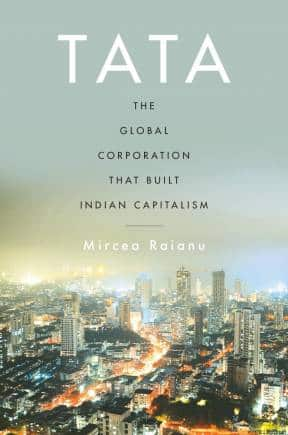



Mircea Raianu’s book Tata: The Global Corporation that Built Indian Capitalism is a study of the Tata Group’s 150-year-old history, beginning with the cotton and opium trade and expanding to sectors like hospitality, aviation, power, chemicals, automobiles, and information technology.
Published by the Harvard University Press and HarperCollins India, this  book is set against the backdrop of India’s freedom struggle and processes of colonization, globalization and liberalization. The author is an assistant professor of history at the University of Maryland. He is a historian of global capitalism and modern South Asia.
book is set against the backdrop of India’s freedom struggle and processes of colonization, globalization and liberalization. The author is an assistant professor of history at the University of Maryland. He is a historian of global capitalism and modern South Asia.
Excerpts from an interview:
What got you interested in studying the history of the Tata Group?When I began thinking about a PhD topic more than a decade ago, I wondered why a full-length academic study of arguably the most important corporate entity in modern Indian history did not yet exist. Despite the fact that we already have many books on Tata, none were written by professional historians. Business history was still seen as a niche field, although that is now changing. Discovering the rich Tata archives in Pune and Jamshedpur, which had not been extensively used, provided further motivation.
Could you talk briefly about the research questions that you began with?Most of all I wanted to know how Tata was able to survive and adapt over time, from its origins in the colonial period through the transitions to Independence in 1947 and market liberalization after 1991. To my knowledge, there are few comparable cases of business firms or groups that have been so prominent for so long. As I tell my American readers in the introduction, imagine if the Rockefellers or Carnegies from a century ago owned Apple or Amazon today! Secondly, I was interested in the relationship between Tata and the Indian nation and its ethos of social responsibility, which made it stand apart.
What took you by surprise while conducting this research?The biggest surprise was just how many domains Tata was involved in, not only through economic activities but also through philanthropy. Writing the book allowed me to explore such diverse aspects as architecture, urban planning, and industrial photography in the steel town of Jamshedpur, from the pioneering designs of Otto Koenigsberger to the evocative images of Sunil Janah; the development of scientific practices and institutions, from Waldemar Haffkine’s plague vaccine to Homi J. Bhabha’s foundation of India’s atomic programme; and lesser-known political stories like the alliance between Jayaprakash Narayan and big business in opposition to the Nehru-Gandhi Congress regime. My hope is that the book is read for what it can tell us about the making of modern India as well as for its insights into business or capitalism.
 Mircea RaianuHow did you deal with the issue of archival silences and erasures?
Mircea RaianuHow did you deal with the issue of archival silences and erasures?It is true that much of the book relies on in-house archival sources collected and curated by the Tata archives in Pune and Jamshedpur. I believe this is one of its strengths. I have also used many other archives, from the Nehru Memorial Museum and Library papers in Delhi to the British Library in London to the US National Archives near my home campus in College Park, Maryland. Rigorous cross-checking allows historians to overcome gaps and limitations in any source base. In the end, it is inevitable that some voices and perspectives will be absent. This is very much a history of the group from within, using available records to unearth contradictions and complexities that would not otherwise be obvious.
What enabled the Tatas to turn a family business into a global corporation?I argue that Tata’s success and resilience is due to three main factors:
1) Financial connections beyond India, especially with East Asia (China and Japan) in the late 19th century and the United States in the mid-20th century;
2) Control over land, labour, and natural resources in places like Jamshedpur in eastern India (where Tata Steel is both an employer and a state-like entity);
3) Networks of experts from around the world, which allowed the group to innovate, experiment, and refine its managerial structure and policies.
I try to stay away from explanations that have to do with individual entrepreneurial genius, community characteristics, or big structural forces.
How would you assess their contribution to India's economic growth?Through the establishment of the first integrated iron and steel plant and hydroelectric power generation system, as well as early moves in sectors like textiles, chemicals, aviation, and automobiles, Tata can claim to have played a significant role in India’s industrialization. Even when some enterprises failed to take off, they laid the groundwork for others to follow. However, Tata’s contributions were somewhat diminished from the early 1950s to the late 1970s, during the state-led push for growth. This was a period, quite unlike what came before and after, when the economic and social value of big business was openly called into question.
To what extent has their success depended on being in the good books of India’s political elite?The relationship between Tata and the state (both colonial and post-colonial) was always difficult. At certain moments, they benefitted from government contracts and political favours, and at others found their expansion frustrated by obstructive regulations (as during the so-called ‘License Raj’ period). Some of their rivals benefited much more. I find that another secret of Tata’s success in the long run has been keeping its distance from the ruling power.
Why do you think they continue to be seen as socially responsible?There is no doubt that struggles over land acquisition in the 2000s, which led to violence in Kalinganagar and Singur, have hurt Tata’s image. But such struggles date back over a century to when business first entered the mineral-rich areas of eastern India. The key difference lies in the promises of employment and social services provided in company towns like Jamshedpur back then. These were not won without conflict, including many labour strikes, with the end result being a more locally rooted and responsive form of capitalism. Tata is far from unique in having abandoned such a model under the pressures of global competitiveness, but its reputation and history still matter greatly.
Discover the latest Business News, Sensex, and Nifty updates. Obtain Personal Finance insights, tax queries, and expert opinions on Moneycontrol or download the Moneycontrol App to stay updated!
Find the best of Al News in one place, specially curated for you every weekend.
Stay on top of the latest tech trends and biggest startup news.